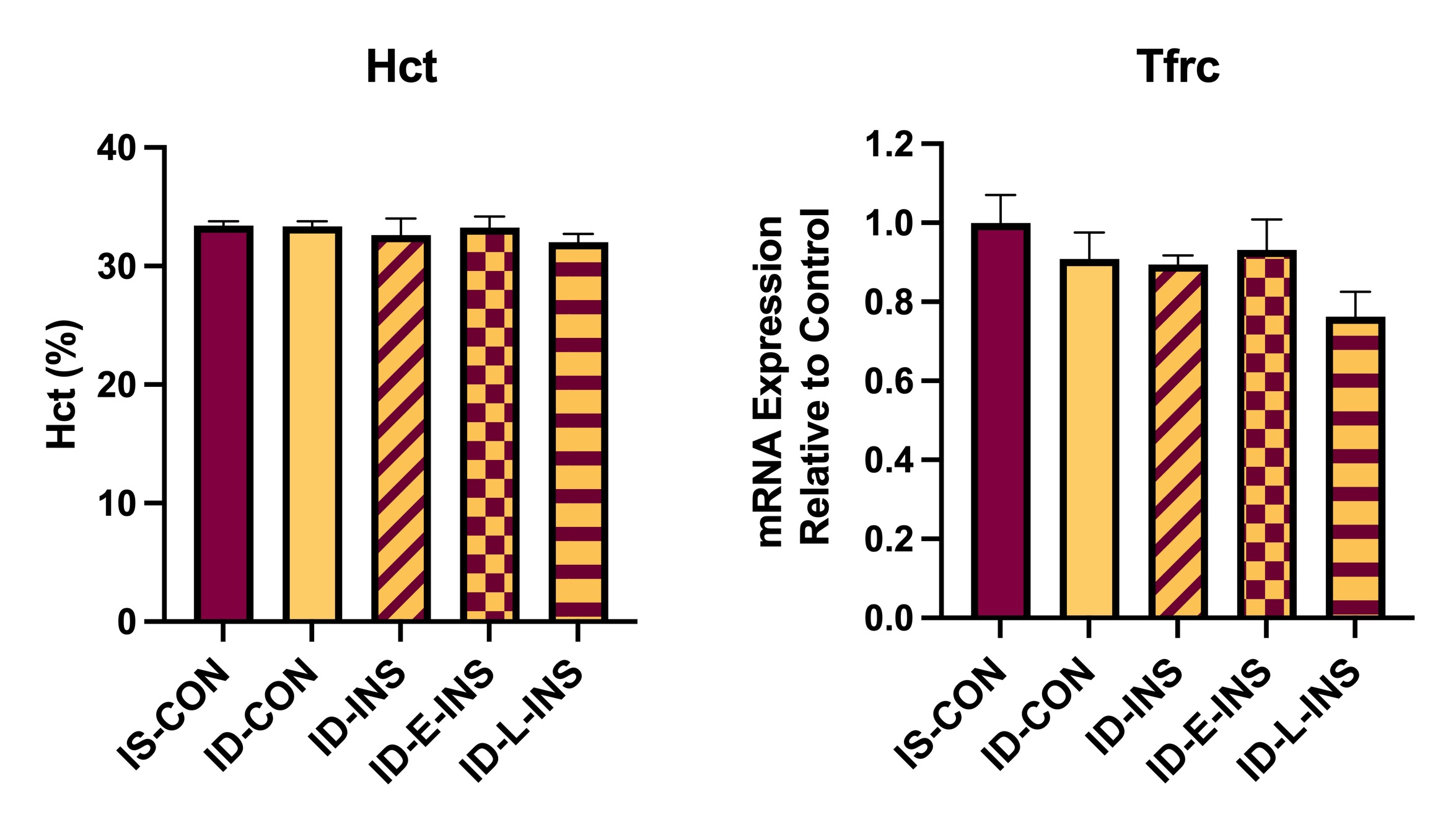Back
Background: Perinatal iron deficiency (PID) impairs energy metabolism, myelination, synaptogenesis and plasticity in the developing hippocampus (HPC). The adverse effects persist long-term despite iron repletion, suggesting the need for adjunct therapies. Intranasal insulin (INS) administration improves HPC structure and function in adult humans with Alzheimer’s Disease and other cognitive disorders. We have shown that 14 days of INS treatment from postnatal days (P) 8-21 during the period of iron repletion partially normalizes the HPC transcriptome altered by PID in neonatal rats. It is unknown whether the timing and/or duration determines the efficacy of INS treatment.
Objective: Compare the efficacy of early (P8-P14, E) vs late (P14-P21, L) INS treatment for ameliorating decreased myelination in the HPC of neonatal rats with PID.
Design/Methods: PID was induced using a low iron (3-6 ppm) diet from gestational day 3 through P7, followed by an iron sufficient (IS; 200 ppm) diet until P21 (ID groups). INS (0.3 IU) was administered twice daily from either P8-14 (ID-E-INS) or P14-21 (ID-L-INS). mRNA expression of iron transporter, transferrin receptor (Tfrc), and marker of myelination, myelin basic protein (Mbp) in the HPC was determined on P21 using qPCR and compared with an IS control (IS-CON) and ID groups untreated with INS (ID-CON) or treated with INS from P8-P21 (ID-INS) (N = 6-8/group).
Results: At P21 hematocrit (Hct, %) and Tfrc mRNA expression were comparable among the 5 groups (Fig. 1). Mbp mRNA expression was lower in the ID-CON group when compared with the IS-CON group. Mbp transcript expression was normalized in the ID-INS and ID-E-INS groups (p < 0.05), but not in the ID-L-INS group (Fig 2).
Conclusion(s): Comparable Hct and Tfrc mRNA expression among the groups suggest resolution of anemia and repletion of HPC iron concentration in the PID groups. Decreased mRNA expression of Mbp in the ID-CON group suggests that PID impairs myelination in the HPC. Normalization of Mbp transcript expression in the ID-INS group suggest that INS treatment improves myelination in the HPC. A similar effect in the ID-E-INS group, but not in the ID-L-INS group suggests that a shorter duration of early INS treatment is effective for overcoming the adverse effects of PID on HPC myelination.
Figure 1.
 Hematocrit and HPC mRNA expression of iron transporter, Tfrc. (Values are Mean +/- SEM, n = 6-8/group)
Hematocrit and HPC mRNA expression of iron transporter, Tfrc. (Values are Mean +/- SEM, n = 6-8/group)
Figure 2.
 HPC mRNA expression Mbp. (Values are Mean +/- SEM, n = 6-8/group. p<0.01 ANOVA; * p<0.05)
HPC mRNA expression Mbp. (Values are Mean +/- SEM, n = 6-8/group. p<0.01 ANOVA; * p<0.05)
Neonatal Neurology 8: Pre-Clinical 2
Session: Neonatal Neurology 8: Pre-Clinical 2
026 - Early Intranasal Insulin Treatment Recovers Hippocampal Myelin Gene Expression in the Developing Hippocampus of Iron Deficient Rat Pups.
Monday, April 28, 2025
7:00am – 9:15am HST
Kathleen M. Ennis-Czerniak, University of Minnesota, Woodbury, MN, United States; Raghavendra Rao, University of Minnesota Medical School, Minneapols, MN, United States
- KE
Kathleen M. Ennis-Czerniak, BA (she/her/hers)
Researcher
University of Minnesota
Woodbury, Minnesota, United States
Presenting Author(s)
Background: Perinatal iron deficiency (PID) impairs energy metabolism, myelination, synaptogenesis and plasticity in the developing hippocampus (HPC). The adverse effects persist long-term despite iron repletion, suggesting the need for adjunct therapies. Intranasal insulin (INS) administration improves HPC structure and function in adult humans with Alzheimer’s Disease and other cognitive disorders. We have shown that 14 days of INS treatment from postnatal days (P) 8-21 during the period of iron repletion partially normalizes the HPC transcriptome altered by PID in neonatal rats. It is unknown whether the timing and/or duration determines the efficacy of INS treatment.
Objective: Compare the efficacy of early (P8-P14, E) vs late (P14-P21, L) INS treatment for ameliorating decreased myelination in the HPC of neonatal rats with PID.
Design/Methods: PID was induced using a low iron (3-6 ppm) diet from gestational day 3 through P7, followed by an iron sufficient (IS; 200 ppm) diet until P21 (ID groups). INS (0.3 IU) was administered twice daily from either P8-14 (ID-E-INS) or P14-21 (ID-L-INS). mRNA expression of iron transporter, transferrin receptor (Tfrc), and marker of myelination, myelin basic protein (Mbp) in the HPC was determined on P21 using qPCR and compared with an IS control (IS-CON) and ID groups untreated with INS (ID-CON) or treated with INS from P8-P21 (ID-INS) (N = 6-8/group).
Results: At P21 hematocrit (Hct, %) and Tfrc mRNA expression were comparable among the 5 groups (Fig. 1). Mbp mRNA expression was lower in the ID-CON group when compared with the IS-CON group. Mbp transcript expression was normalized in the ID-INS and ID-E-INS groups (p < 0.05), but not in the ID-L-INS group (Fig 2).
Conclusion(s): Comparable Hct and Tfrc mRNA expression among the groups suggest resolution of anemia and repletion of HPC iron concentration in the PID groups. Decreased mRNA expression of Mbp in the ID-CON group suggests that PID impairs myelination in the HPC. Normalization of Mbp transcript expression in the ID-INS group suggest that INS treatment improves myelination in the HPC. A similar effect in the ID-E-INS group, but not in the ID-L-INS group suggests that a shorter duration of early INS treatment is effective for overcoming the adverse effects of PID on HPC myelination.
Figure 1.
 Hematocrit and HPC mRNA expression of iron transporter, Tfrc. (Values are Mean +/- SEM, n = 6-8/group)
Hematocrit and HPC mRNA expression of iron transporter, Tfrc. (Values are Mean +/- SEM, n = 6-8/group)Figure 2.
 HPC mRNA expression Mbp. (Values are Mean +/- SEM, n = 6-8/group. p<0.01 ANOVA; * p<0.05)
HPC mRNA expression Mbp. (Values are Mean +/- SEM, n = 6-8/group. p<0.01 ANOVA; * p<0.05)
